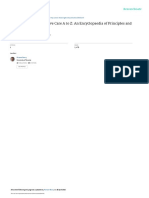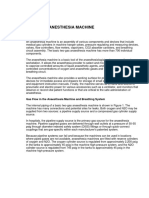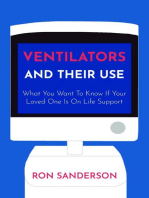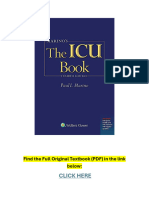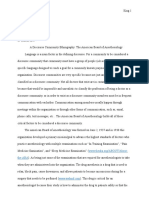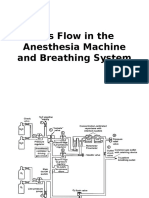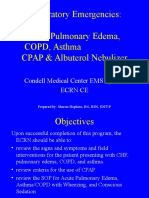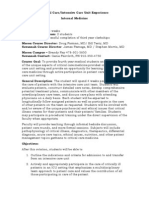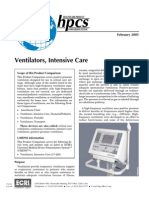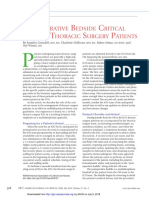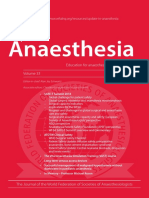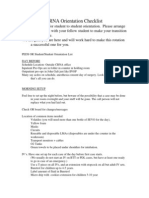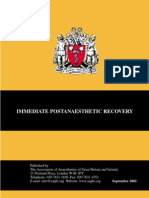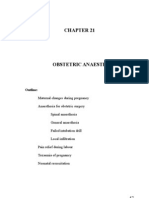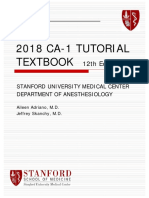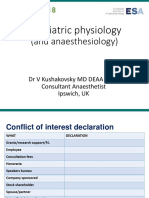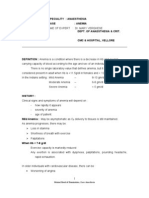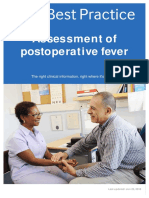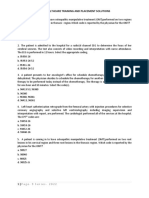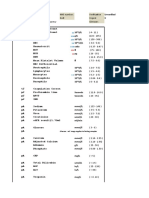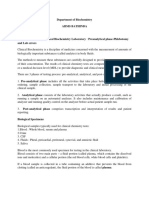Anaesthetic Machine
Anaesthetic Machine
Uploaded by
Amjad MadaniCopyright:
Available Formats
Anaesthetic Machine
Anaesthetic Machine
Uploaded by
Amjad MadaniOriginal Description:
Original Title
Copyright
Available Formats
Share this document
Did you find this document useful?
Is this content inappropriate?
Copyright:
Available Formats
Anaesthetic Machine
Anaesthetic Machine
Uploaded by
Amjad MadaniCopyright:
Available Formats
Anaesthetic machine
Anaesthetic machine
The anaesthetic machine (or anesthesia machine in America) is used by anaesthesiologists and Nurse anesthetists to support the administration of anaesthesia. The most common type of anaesthetic machine in use in the developed world is the continuous-flow anaesthetic machine, which is designed to provide an accurate and continuous supply of medical gases (such as oxygen and nitrous oxide), mixed with an accurate concentration of anaesthetic vapour (such as isoflurane), and deliver this to the patient at a safe pressure and flow. Modern machines incorporate a ventilator, suction unit, and patient-monitoring devices. The original concept of Boyle's machine was invented by the British anaesthetist H.E.G. Boyle in 1917. Prior to this time, anaesthetists often carried all their equipment with them, but the development of heavy, bulky cylinder storage and increasingly elaborate airway equipment meant that this was no longer practical for most circumstances. The anaesthetic machine is usually mounted on anti-static wheels for convenient transportation.
An anaesthetic machine
Simpler anaesthetic apparatus may be used in special circumstances, such as the TriService Apparatus, a simplified anaesthesia delivery system invented for the British armed forces, which is light and portable and may be used effectively even when no medical gases are available. This device has unidirectional valves which suck in ambient air which can be enriched with oxygen from a cylinder,with the help of a set of bellows. A large number of draw-over type of anaesthesia devices are still in use in India for administering an air-ether mixture to the patient, which can be enriched with oxygen. But the advent of the cautery has sounded the death knell to this device, due to the explosion hazard. Many of the early innovations in U.S. anaesthetic equipment, including the closed circuit carbon-dioxide absorber (aka: the Guedel-Foregger Midget) and diffusion of such equipment to anaesthetists within the United States can be attributed to Dr. Richard von Foregger and The Foregger Company. In dentistry a simplified version of the anaesthetic machine, without a ventilator or anesthetic vaporiser, is referred to as a Relative analgesia machine. By using this machine, the dentist can administer a mild inhalation sedation with nitrous oxide and oxygen, in order to keep his patient in a conscious state while depressing the feeling of pain.
Anaesthetic machine
Components of a typical machine
A modern machine typically includes the following components: connections to piped hospital oxygen, medical air, and nitrous oxide. Pipeline pressure from the hospital medical gas system (wall outlet) should be around 400 kPa (60 psi; 4 atmospheres). reserve gas cylinders of oxygen, air, and nitrous oxide attached via a specific yoke with a Bodok seal. Older machines may have cylinder yokes and flow meters for carbon dioxide and cyclopropane. Many newer machines only have oxygen reserve cylinders. The regulators for the cylinders are set at Simple schematic of an anaesthesia machine 300 kPa (45 psi; 3 atmospheres). If the cylinders are left on and the machine is plugged into the wall outlet, gas from the wall supply will be used preferentially, since it is at a higher pressure. In situations where pipeline gases are not available, machines may safely be used from cylinders alone, provided fresh cylinders are available. a high-flow oxygen flush which provides pure oxygen at 30 litres/minute pressure gauges, regulators and 'pop-off' valves, to protect the machine components and patient from high-pressure gases (referred to as 'barotrauma'). flow meters (rotameters) for oxygen, air, and nitrous oxide, which are used by the anaesthesiologist to provide accurate mixtures of medical gases to the patient. Flow meters are typically pneumatic, but increasingly electromagnetic digital flow meters are being used. one or more anaesthetic vaporisers to accurately add volatile anaesthetics to the fresh gas flow a ventilator physiological monitors to monitor the patient's heart rate, ECG, non-invasive blood pressure and oxygen saturation (additional monitors are generally available to monitor end-tidal CO2, temperature, arterial blood pressure central venous pressure, etc.). In addition, the composition of the gases delivered to the patient (and breathed out) is monitored continuously. breathing circuits, most commonly a circle attachment, or a Bain's breathing system, which are breathing hoses connected to a anaesthesia face mask a heat and moisture exchanger (HME) with or without bacteria-viral filter (HMEF). scavenging system to remove expired anaesthetic gases from the operating room. Scavenged gases are usually vented to the atmosphere. suction apparatus There is generally a small work bench built into the machine where airway management equipment is kept within ready reach of the anaesthetist.
Anaesthetic machine
Safety features of modern machines
Based on experience gained from analysis of mishaps, the modern anaesthetic machine incorporates several safety devices, including: an oxygen failure alarm (also known as 'Oxygen Failure Warning Device' or OFWD). In older machines this was a pneumatic device called a Ritchie whistle. Newer machines have an electronic sensor. nitrous cut-off: the flow of medical nitrous-oxide is dependent on oxygen pressure. This is done at the regulator level. In essence, the nitrous-oxide regulator is a 'slave' of the oxygen regulator. hypoxic-mixture alarms (hypoxy guards or ratio controllers) to prevent gas mixtures which contain less than 21% oxygen being delivered to the patient. In modern machines it is impossible to deliver 100% nitrous oxide (or any hypoxic mixture) to the patient to breathe. Oxygen is automatically added to the fresh gas flow even if the anaesthetist should attempt to deliver 100% nitrous oxide. Ratio controllers usually operate on the penumatic principle or are chain linked. Both are located on the rotameter assembly, unless electronically controlled. ventilator alarms, which warn of disconnection or high airway pressures interlocks between the vaporisers preventing inadvertent administration of more than one volatile agent concurrently alarms on all the above physiological monitors the Pin Index Safety System prevents cylinders being accidentally connected to the wrong yoke the NIST (Non-Interchangeable Screw Thread) system for pipeline gases, which prevents piped gases from the wall being accidentally connected to the wrong inlet on the machine pipeline gas hoses have non-interchangeable Schrader valve connectors, which prevents hoses being accidentally plugged into the wrong wall socket The functions of the machine should be checked at the beginning of every operating list in a "cockpit-drill". Machines and associated equipment must be maintained and serviced regularly. Older machines may lack some of the safety features and refinements present on newer machines. However, they were designed to be operated without mains electricity, using compressed gas power for the ventilator and suction apparatus. Modern machines often have battery backup, but may fail when this becomes depleted. The modern anaesthetic machine still retains all the key working principles of the Boyle's machine (a British Oxygen Company trade name) in honour of the British anaesthetist H.E.G. Boyle (18751941). In India, however, the trade name 'Boyle' is registered with Boyle HealthCare Pvt. Ltd., Indore MP. A two-person (Operating Theatre Practitioner and anaesthetist) pre-use check of the anaesthetic machine is recommended before every single case and has been shown to decrease the risk of 24-hour severe postoperative morbidity and mortality (Arbous et al. Anesthesiology 2005). Various regulatory and professional bodies have formulated checklists for different countries - see http:/ / vam. anest. ufl. edu/ guidelines. html. A free transparent reality simulation of the checklist recommended by the United States Food & Drug Administration is available from the Virtual Anesthesia Machine web site ( see below) after registration which is also free. Machines should be cleaned between cases as they are at considerable risk of contamination with pathogens.[1]
Anaesthetic machine
See also
Boyle's machine
External links
Virtual Anesthesia Machine (VAM) [2] a free transparent reality simulation of a generic anesthesia machine from the University of Florida Various anesthesia-related simulations [3] Virtual Anaesthesia Textbook [4] FRCA UK [5] resources for UK anaesthetist in training History of Dr. Richard von Foregger and the Foregger Company [6] written by his son, Dr. R. Foregger, this website chronicles one of the leading manufacturers and developers of anesthesiology equipment in the early 20th century. Critical Care News [7] a peer-to-peer forum for intensive care clinicians to share experiences in ventilation therapies
References
[1] Baillie, J.K.; P. Sultan, E. Graveling, C. Forrest, C. Lafong (2007-12). "Contamination of anaesthetic machines with pathogenic organisms". Anaesthesia 62 (12): 12571261. [2] http:/ / vam. anest. ufl. edu/ wip. html [3] http:/ / www. simanest. org/ [4] http:/ / www. virtual-anaesthesia-textbook. com/ vat/ machine. htm [5] http:/ / www. frca. co. uk/ [6] http:/ / www. lifelongcompany. com/ [7] http:/ / www. criticalcarenews. com
Article Sources and Contributors
Article Sources and Contributors
Anaesthetic machine Source: http://en.wikipedia.org/w/index.php?oldid=357327185 Contributors: Alex.tan, Alxcus, Arfgab, CalviNet, CatherineMunro, Chrisjw, Danish Expert, Diptanshu.D, Dratuldixit5, Erich gasboy, Finavon, Gene Nygaard, Grendelkhan, Jason Quinn, JimCook, Jpbowen, Koshime, LilHelpa, Mark.murphy, Michael Devore, Myxoma, NCurse, Onionmon, Preacherdoc, Quuxplusone, R. S. Shaw, RexNL, Rich Farmbrough, Sarahfo, Sietse Snel, Some standardized rigour, Stephan Leeds, Template namespace initialisation script, Versageek, Xp54321, YUL89YYZ, Yama, Yinchongding, 35 anonymous edits
Image Sources, Licenses and Contributors
Image:Latex-free project 111.jpg Source: http://en.wikipedia.org/w/index.php?title=File:Latex-free_project_111.jpg License: unknown Contributors: Original uploader was Chrisjw at en.wikipedia Image:anesthesia machine simple schm.png Source: http://en.wikipedia.org/w/index.php?title=File:Anesthesia_machine_simple_schm.png License: Creative Commons Attribution-Sharealike 3.0 Contributors: User:TwoOneTwo
License
Creative Commons Attribution-Share Alike 3.0 Unported http:/ / creativecommons. org/ licenses/ by-sa/ 3. 0/
You might also like
- Compendi o Pascoe 2002Document493 pagesCompendi o Pascoe 2002Pablo Matas Soria100% (2)
- Mechanical VentilationDocument13 pagesMechanical VentilationNithiya NadesanNo ratings yet
- MOVES SLC Operator ManualDocument362 pagesMOVES SLC Operator ManualPoh Yu JianNo ratings yet
- Anaesthesia and Intensive Care A To Z An EncyclopaDocument2 pagesAnaesthesia and Intensive Care A To Z An EncyclopaTripon AmyNo ratings yet
- Color Code Anesthesia PDFDocument6 pagesColor Code Anesthesia PDFYusnia Gulfa MaharaniNo ratings yet
- Functional and Work Outcomes Improve in Patients With Rheumatoid Arthritis Who Receive Targeted, Comprehensive Occupational TherapyDocument9 pagesFunctional and Work Outcomes Improve in Patients With Rheumatoid Arthritis Who Receive Targeted, Comprehensive Occupational TherapyispasNo ratings yet
- The Basic Anaesthetic MachineDocument6 pagesThe Basic Anaesthetic Machineluis7lobato-2100% (1)
- Carestation 650 Brochure PDFDocument12 pagesCarestation 650 Brochure PDFzulfiah100% (1)
- Scientific ProgrammeDocument80 pagesScientific ProgrammevictoryNo ratings yet
- Who Should Be Admitted To The Intensive Care UnitDocument5 pagesWho Should Be Admitted To The Intensive Care UnitKary VelazquezNo ratings yet
- Introduction To Mechanical VentilationDocument5 pagesIntroduction To Mechanical VentilationHussam GujjarNo ratings yet
- Anaesthesia & Intensive Care Medicine Volume 14 Issue 3 2013 (Doi 10.1016/j.mpaic.2013.01.006) Hawthorne, Christopher Sutcliffe, Nick - Total Intravenous Anaesthesia PDFDocument3 pagesAnaesthesia & Intensive Care Medicine Volume 14 Issue 3 2013 (Doi 10.1016/j.mpaic.2013.01.006) Hawthorne, Christopher Sutcliffe, Nick - Total Intravenous Anaesthesia PDFAnonymous nbU88FeNo ratings yet
- Anaesthesia For Bariatric SurgeryDocument7 pagesAnaesthesia For Bariatric SurgeryDragos IonixNo ratings yet
- Anes PDFDocument1 pageAnes PDFdarksuiko100% (1)
- Anesthesia - State of Narcosis, Analgesia, Relaxation, and Loss of Reflex. Effects of AnesthesiaDocument3 pagesAnesthesia - State of Narcosis, Analgesia, Relaxation, and Loss of Reflex. Effects of AnesthesiaJhevilin RMNo ratings yet
- Physics and AnaesthesiaDocument6 pagesPhysics and AnaesthesiaSuresh Kumar100% (1)
- Surgical Safety Checklist ProjectDocument5 pagesSurgical Safety Checklist ProjectKeshava NagalkarNo ratings yet
- 7..intravenous Anaesthesia 2Document23 pages7..intravenous Anaesthesia 2Mwiliza BrendaNo ratings yet
- Anesthesia TechnologyDocument56 pagesAnesthesia TechnologyDeepali SinghNo ratings yet
- WFSA UpdateDocument60 pagesWFSA UpdateSyaiful FatahNo ratings yet
- The Anatomical Foundations of Regional Anesthesia and Acute Pain MedicineFrom EverandThe Anatomical Foundations of Regional Anesthesia and Acute Pain MedicineNo ratings yet
- Perioperative Management of Fluids and Electrolytes in ChildrenDocument6 pagesPerioperative Management of Fluids and Electrolytes in ChildrenBetyCamarilloNo ratings yet
- Awareness During General Anesthesia Concepts andDocument8 pagesAwareness During General Anesthesia Concepts andR KNo ratings yet
- Anesthesia Resident Requirements PDFDocument21 pagesAnesthesia Resident Requirements PDFJulieNo ratings yet
- Marino's The ICU Book 4th Edition PDFDocument26 pagesMarino's The ICU Book 4th Edition PDFtadon92475No ratings yet
- PhysicsDocument157 pagesPhysicsAndreea StancuNo ratings yet
- Essay 3 Final DraftDocument6 pagesEssay 3 Final Draftapi-360460383No ratings yet
- Gas Flow in The Anesthesia Machine and BreathingDocument12 pagesGas Flow in The Anesthesia Machine and BreathingVennySoentantoNo ratings yet
- ModuleIV RespiratoryEmergencies CHF COPD AsthmaDocument96 pagesModuleIV RespiratoryEmergencies CHF COPD AsthmaSaiKiranNo ratings yet
- Mechanical VentilationDocument18 pagesMechanical VentilationAlka GoyalNo ratings yet
- Critical Care/Intensive Care Unit Experience Internal Medicine INM.M INM.S CourseDocument11 pagesCritical Care/Intensive Care Unit Experience Internal Medicine INM.M INM.S CourseAmer Moh SarayrahNo ratings yet
- Critical Thinking in Respiratory Care Practice PDFDocument17 pagesCritical Thinking in Respiratory Care Practice PDFFernando MorenoNo ratings yet
- General Anaesthesia: Anaesthesia and Critical Care DeptDocument46 pagesGeneral Anaesthesia: Anaesthesia and Critical Care DeptAnonymous A2d5hUNeMiNo ratings yet
- Ventilators, Intensive CareDocument48 pagesVentilators, Intensive CarealetripoleNo ratings yet
- Advanced Chronic Obstructive Pulmonary DiseaseDocument39 pagesAdvanced Chronic Obstructive Pulmonary Diseases1882No ratings yet
- Post Operative Bedside Thoracic Surgery 2018Document7 pagesPost Operative Bedside Thoracic Surgery 2018Devi SiswaniNo ratings yet
- Anesthetic MachineDocument80 pagesAnesthetic MachinemichaelNo ratings yet
- UiA 33 Final Replacement Web 2Document80 pagesUiA 33 Final Replacement Web 2uzairNo ratings yet
- MsmaidsDocument31 pagesMsmaidsnbrassarNo ratings yet
- Anaesthesia MachineDocument51 pagesAnaesthesia Machinem07wwp100% (1)
- Hypothermia and Temperature Regulation Considerations During AnesthesiaDocument20 pagesHypothermia and Temperature Regulation Considerations During AnesthesiaAgung Bhaktiyar100% (1)
- SRNA Orientation ChecklistDocument40 pagesSRNA Orientation Checklistihtisham1No ratings yet
- Immediate Post Anesthetic RecoveryDocument12 pagesImmediate Post Anesthetic Recoverysubvig100% (2)
- CH 21 Obstetric AnaesthesiaDocument39 pagesCH 21 Obstetric AnaesthesiaChristian LeepoNo ratings yet
- Flotrac: Vigileo VN PDFDocument2 pagesFlotrac: Vigileo VN PDFelipelyNo ratings yet
- Context Sensitive Half Time (CSHT) - The Lay Medical ManDocument3 pagesContext Sensitive Half Time (CSHT) - The Lay Medical Manpradeep danielNo ratings yet
- Ventilation Handbook WordDocument55 pagesVentilation Handbook WordHndr100% (2)
- Final - 2018 CA-1 Tutorial Textbook - Smartphone or Tablet-3Document342 pagesFinal - 2018 CA-1 Tutorial Textbook - Smartphone or Tablet-3Nick-Hugh Wisdom100% (1)
- Liver Segments Explained With MnemonicDocument13 pagesLiver Segments Explained With Mnemonicmyat252100% (1)
- Obesity & Anaesthesia: Co-Ordinator - Dr. Chavi Sethi (MD) Speaker - Dr. Uday Pratap SinghDocument56 pagesObesity & Anaesthesia: Co-Ordinator - Dr. Chavi Sethi (MD) Speaker - Dr. Uday Pratap SinghRafi ramdhanNo ratings yet
- 2 TIVA - TCI RevisionDocument25 pages2 TIVA - TCI RevisionMora GalliNo ratings yet
- Transport of Critically Ill PatientDocument26 pagesTransport of Critically Ill PatientHayatul AkmaLia0% (1)
- Geriatric Anesthesiology 3ed 2018Document509 pagesGeriatric Anesthesiology 3ed 2018Cristina ObandoNo ratings yet
- 04.06.2018 - 6 - V. Kushakovsky - Pediatric AnaesthesiaDocument46 pages04.06.2018 - 6 - V. Kushakovsky - Pediatric AnaesthesiaPhilippe KinnaerNo ratings yet
- Evidence-Based Obstetric AnesthesiaFrom EverandEvidence-Based Obstetric AnesthesiaStephen H. HalpernNo ratings yet
- Anaesthesia and Sedation Outside TheatresDocument15 pagesAnaesthesia and Sedation Outside Theatresمحمد زينNo ratings yet
- AnaesthesiaDocument121 pagesAnaesthesiaSandeep Bhangale100% (2)
- Assessment of Postoperative Fever BMJDocument40 pagesAssessment of Postoperative Fever BMJMario Guzmán GutiérrezNo ratings yet
- Why Dentistry Fails The 10 Must Know Factors of Occlusion The Dawson Academy 2021 WhitepaperDocument3 pagesWhy Dentistry Fails The 10 Must Know Factors of Occlusion The Dawson Academy 2021 WhitepaperManuel Castillo100% (1)
- Icd 10 CM Pcs Coding Theory and Practice 2017 Edition 1st Edition Lovaasen Test BankDocument12 pagesIcd 10 CM Pcs Coding Theory and Practice 2017 Edition 1st Edition Lovaasen Test Bankgisellephongejs100% (42)
- PONCHO TrialDocument8 pagesPONCHO Trialrahul krishnanNo ratings yet
- Laporan Pemakaian Dan Lembar Permintaan Obat (Lplpo) PuskesmasDocument14 pagesLaporan Pemakaian Dan Lembar Permintaan Obat (Lplpo) PuskesmasYuliNo ratings yet
- Feline Plasma Cell Pododermatitis - A Study of 8 Cases (Pages 333-337) PDFDocument5 pagesFeline Plasma Cell Pododermatitis - A Study of 8 Cases (Pages 333-337) PDFjenNo ratings yet
- G11 Caregiving 2ND Quarter ExamDocument5 pagesG11 Caregiving 2ND Quarter ExamMaki Cabuena100% (1)
- 9 - Series 2022Document8 pages9 - Series 2022Vijay UNo ratings yet
- Hierarchy of O2 Delivery SystemsDocument1 pageHierarchy of O2 Delivery SystemsRevNo ratings yet
- Voluntary Counselling and Testing (VCT) Hiv Dan AidsDocument7 pagesVoluntary Counselling and Testing (VCT) Hiv Dan AidsNeri Bela RestuNo ratings yet
- ANTIEMETICSDocument14 pagesANTIEMETICSNathaniel Mbiu TimNo ratings yet
- Therapeutic Hotline: Pruritic Papular Eruption in HIV: A Case Successfully Treated With NB-UVBDocument3 pagesTherapeutic Hotline: Pruritic Papular Eruption in HIV: A Case Successfully Treated With NB-UVBalivanabilafarinisaNo ratings yet
- Community Medicine LumhsDocument3 pagesCommunity Medicine LumhsShafaque Irfan100% (1)
- Anemia in ChildrenDocument4 pagesAnemia in ChildrenTeslim Raji100% (2)
- Product Catalog 2Document2 pagesProduct Catalog 2Ahmed GunaidNo ratings yet
- What Is IntussusceptionDocument11 pagesWhat Is IntussusceptionNatoya ChristieNo ratings yet
- Levels of Prevention (Leavell & Clark)Document10 pagesLevels of Prevention (Leavell & Clark)Ta RaNo ratings yet
- Z+blood Groups....Document36 pagesZ+blood Groups....ilhamaminsyaputraNo ratings yet
- Atls MedscapeDocument5 pagesAtls MedscapeCastay GuerraNo ratings yet
- Position SoughtDocument1 pagePosition Soughtapi-301736694No ratings yet
- Investigations Template For Simulation ScenariosDocument5 pagesInvestigations Template For Simulation ScenariosAshley CheungNo ratings yet
- Mohney and Holmes' Intermittent Exotropia Control ScoringDocument4 pagesMohney and Holmes' Intermittent Exotropia Control ScoringLalo ZaraloNo ratings yet
- Orientation To Clinical Biochemistry-PreanalyticalDocument6 pagesOrientation To Clinical Biochemistry-PreanalyticalasjxhiBBniu01j2No ratings yet
- Rectal ExaminationDocument21 pagesRectal ExaminationAlexandra HornariuNo ratings yet
- Katritsis Et Al 2021 Electroanatomic Characterization and Ablation of Scar Related Isthmus Sites Supporting PerimitralDocument13 pagesKatritsis Et Al 2021 Electroanatomic Characterization and Ablation of Scar Related Isthmus Sites Supporting PerimitralAndrés AllaucaNo ratings yet
- Harvesting Hope: Regulating and Incentivizing Organ DonationDocument31 pagesHarvesting Hope: Regulating and Incentivizing Organ DonationNew England Law ReviewNo ratings yet
- Living Donor Advocacy BrochureDocument7 pagesLiving Donor Advocacy BrochureVictorNo ratings yet
- HerniaDocument11 pagesHerniaHapsari Wibawani 'winda'100% (1)
- PRP For Hair Loss Pre Post Instructions 10.18Document2 pagesPRP For Hair Loss Pre Post Instructions 10.18Selvabala904260No ratings yet



